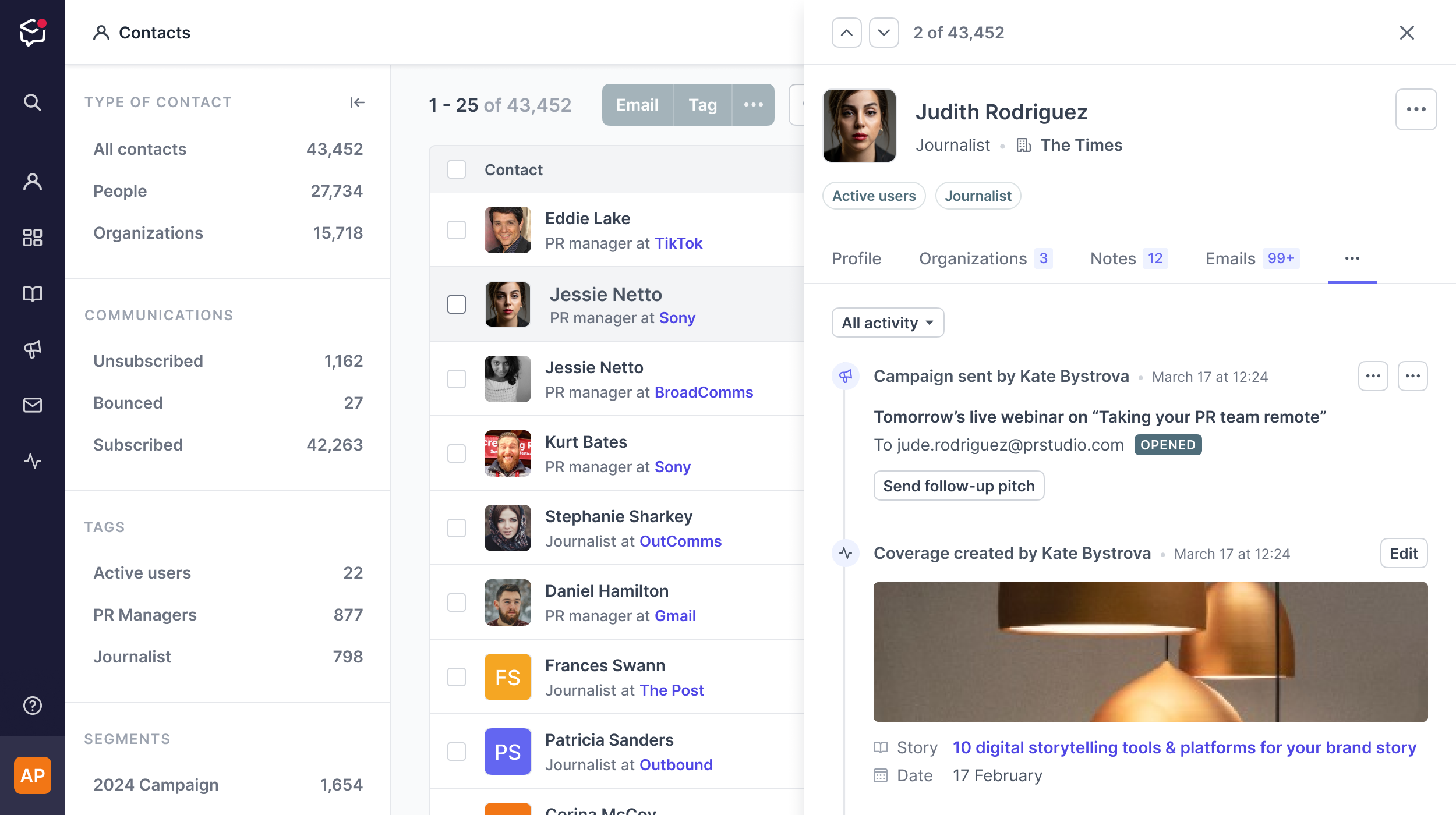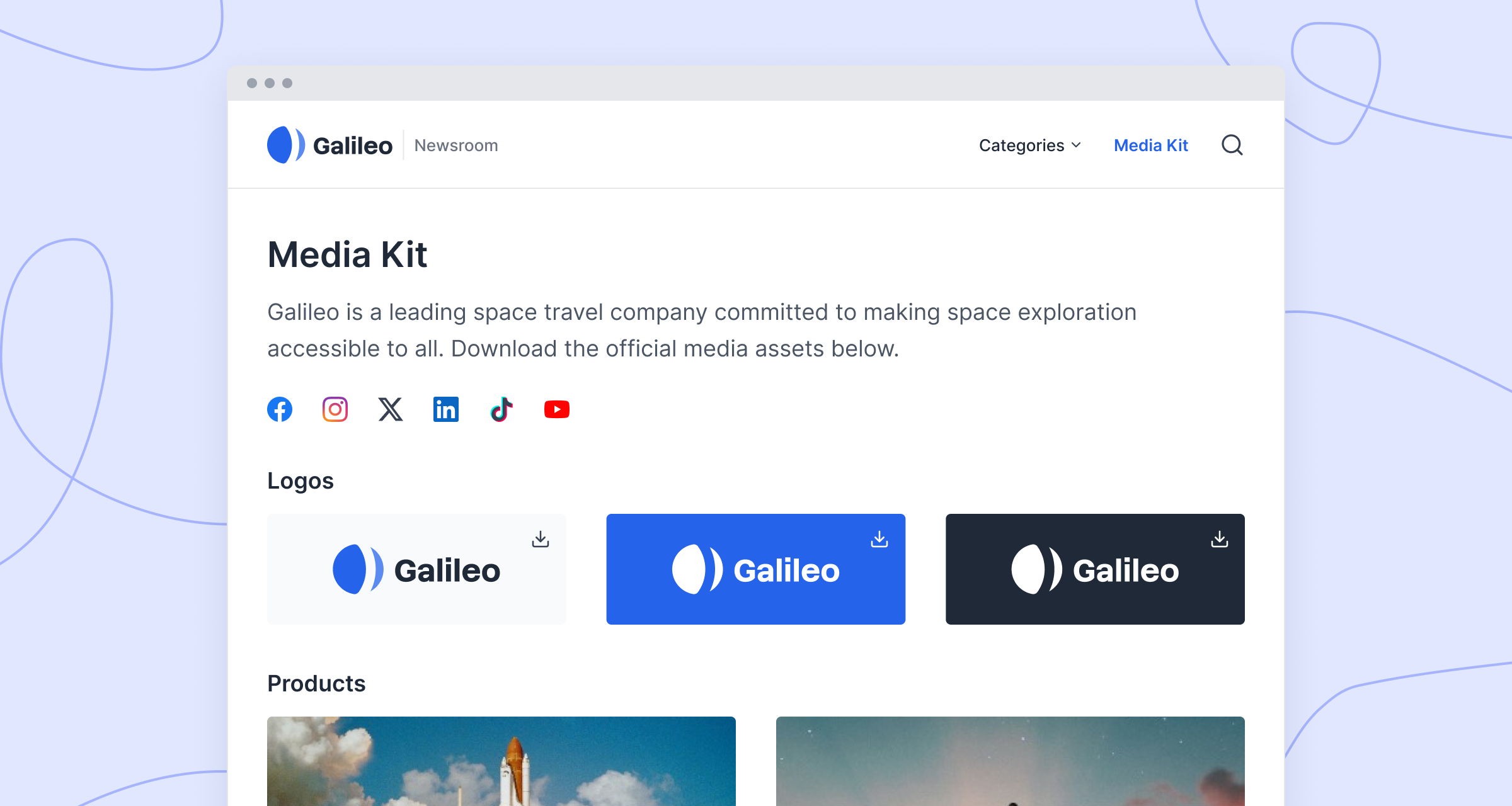How to create a PR strategy in 2025: Examples, tips, templates & more
And before you ask, no, PR tactics aren't a strategy.
Want to make your brand stand out in a crowded market? A well-crafted PR strategy can boost awareness, shape brand perception, and drive revenue.
Whether you’re refreshing an old plan or starting from scratch, this step-by-step guide will help you create a winning strategy for lasting success.
Now let's go get em, tiger.
Prezly – software for modern PR teams
Write & publish brand stories in an online newsroom
Send email campaigns, pitches & newsletters
Manage all your contacts in a single CRM, with easy import & export
Measure performance with analytics & built-in media monitoring

A PR strategy is a plan to build and maintain a positive public image for a person, organization, product, or brand. It focuses PR efforts by outlining clear goals and PR tactics at the outset, before the actual PR work begins.
The best PR strategy will also tie in with broader business goals.
A strong PR strategy provides clear goals, helps you stay on track, and prepares you for potential challenges. It boosts brand visibility, attracts attention, and tracks public relations campaign success, supporting long-term growth and reputation management.
From a practical standpoint, the three main benefits of having an effective PR strategy are:
Ultimately, the goal of any business is to convert leads. (Non-profits and governmental organizations may use different metrics, but the idea is the same.)
To that end, a good PR strategy increases brand exposure. By gaining press coverage for your brand and getting key messages to the target audience, you create opportunities for your marketing team to convert interest into revenue.
Whatever else your PR strategy aims to achieve, raising awareness of your brand will be an integral focus of it. By placing your message in the right media and industry discussions, you ensure your brand reaches the right audience and builds on that same audience, improving recognition and promoting a positive brand image.
An effective PR strategy prepares you for potential crises that could affect your brand or its people. With crisis communications plans in place for handling PR crises, you can respond quickly and protect your positive brand reputation, minimizing any damage during tough situations.
Use the below PR strategy template to work out a direction for your own campaign. This has been filled out with example answers to help you get started.
| Example answers |
|---|---|
What is my goal? | To launch our new product, themed hats for cats |
Who is my audience? | Playful cat enthusiasts who prioritise spending time (and dollars) on their pets |
Where do they spend time? | Social media platforms (TikTok, IG) |
What's my budget? | $25,000 |
What tactics will I use to reach my goal? | - TikTok and Instagram video content creation |
What will I measure? | - Site traffic from socials and branded search |
What is the timeline? | Launch day is February 14th |
What will success look like? | 50,000 orders placed across the company website and distributors by April 1st |
Use this outline as a guide to create a detailed, actionable public relations strategy tailored to your business objectives and needs. Each section is designed to help public relations professionals align your PR efforts with measurable objectives and effective tactics.
- What do you want to achieve? e.g. to increase brand awareness, drive sales, launch a new product, improve employee morale, manage a crisis
- How does this align with the broader goals of the company/organization? e.g. how will this support marketing, recruitment, community engagement
- Analyze your current channels and presence:
- Website: Is it user-friendly and aligned with your messaging?
- Social media: How engaged is your audience?
- Recent media coverage: Was it positive, negative, or neutral?
- Evaluate messaging:
- Are your communication efforts resonating with your audience?
- Identify gaps or inconsistencies in tone, content, and format
- Segment your audience:
- Define key demographics (e.g. age, location, income)
- Explore psychographics (e.g. interests, behaviors, aspirations)
- Identify niche audience preferences:
- Where do they get their news?
- Which social platforms or media voices do they trust?
- What's the public perception of your brand?
- Specific: Focus on clear, actionable goals, e.g. "Increase positive brand mentions by 25%”
- Measurable: Define how success will be tracked (e.g. traffic, leads)
- Attainable: Ensure goals are realistic within resources
- Relevant: Align objectives with audience priorities
- Time-bound: Include deadlines (e.g. "Achieve results within six months")
- Choose public relations tactics that align with your goals and target audience:
- Media outreach: Build positive relationships with journalists and pitch relevant stories
- Press releases: Announce major news or initiatives
- PR thought leadership: Publish articles, blog posts/guest blogging, or host webinars to establish expertise
- Social media PR: Leverage platforms for broader reach and engagement on specific social media channels, and grow your online presence
- Influencer marketing PR: Collaborate with trusted figures to amplify your message across social channels
- Corporate events and videos: Humanize your brand and create engaging content that can be used on social platforms
- Also think about how other teams can contribute tactics to a solid PR strategy, e.g. newsroom search engine optimization from marketing, customer loyalty campaigns and customer review from CS, etc
- Organize milestones and deadlines:
- Use a content calendar to map out key activities
- Work backward from launch dates to allocate time for preparation and review
- Assign responsibilities, defining team roles and ensuring accountability for each task
- Track key performance indicators (KPIs) – these could be engagement rates, site traffic, media impressions, share of voice, sentiment analysis…
- Analyze outcomes by comparing results against objectives to assess success
- Adjust tactics using insights from the work you’ve already done
- There are plenty of PR tools on the market that can help you to, e.g.
- Track media mentions and key audience sentiment
- Identify journalists and influencers in your industry
- Understand how people engage with your online content
Comprehensive PR software like Prezly can help you enact your PR plan once you have one in place – here's a quick introduction to what you can expect:
Try Prezly for freeOk, so we've gone through the serious business of how to put together a meaty public relations strategy. Now, for the gravy on top.
Here's the advice we all wish we'd had the first time we set out to run a public relations campaign.
Trying to do too much at once is a surefire way to burn out
It's always better to do a few things really, really well than a dozen things poorly.
So once you've decided on the tactics you will use, it's worth noting down the tactics you're going to steer well away from. Then you won't find yourself – or your CEO – insisting on doing work that does not fit in to your comprehensive PR strategy.
PR should never be done in isolation from the rest of the company – that only leads to a waste of effort, money and mental health.
And factor in everything. Speak with key stakeholders, employee advocates, your customer base, people who might not be fans of the company at all. Talk to everybody and start to get a picture of the things that would have to change in order for the business to achieve its goals.
Then do more research to see what you can do to help make that change happen.
And this sort of research doesn't have to cost a million bucks. Tools like SparkToro will help you.
We have one client who, three years ago, was trying to figure out where to spend their time online. And so they sent a Survey Monkey and they just said, when you're on social media, which social networks do you participate in?
And then they broke it down personally and professionally, and it was really easy to get that kind of information.
Now is the time to take all that research you did and make it tangible.
What will success look like in the short, medium and long term?
Work your goals out with your main stakeholders, write them down, and assign numbers to them so that you know what you're aiming for.
Once you know what you want to achieve (so, the thing that aligns with the business goals) and you've done your research into what needs to change in order for you to achieve that (the measurable thing that will tell you that you're making progress), you can start breaking that down into the hands-on, day-to-day tactics you will use to make it all happen.
And remember, you don't have to do everything all at once.
So you want to start with research first, and then figure out, OK, where does the PESO Model fit, and what kinds of things do I do?
You wouldn't necessarily launch with everything – 'We're going to do paid, earned, shared and owned.' We might start with owned, and then go to shared, and then go to earned, and then go to paid. So there's a lot lots of different things that go into it.
FYI: If you aren't familiar with the PESO model, head on over to this excellent PESO guide over at Spin Sucks and take some notes. You won't regret it.
Once you know what metrics you're trying to affect, having outlined your public relations strategy and the tactics that will carry you through to victory, measure everything. (Here's a handy list of excellent PR analytics tools that can help!)
Measure before you start doing anything, so you know where the starting line is.
Measure at regular intervals as you carry out your plan, so you know if you're on the right track and can demonstrate the value of your work.
Measure at the end to show the difference you have made.
Measure your PR with a free trialWhen you've developed your PR marketing strategy, you have to develop your tactical plan to ensure a return on investment. Once you develop your plan, you need to stick to it so that you're on time, you're on budget, and you're consistently making progress in the right direction.
That's a lot to keep track of, so use a tool to help keep everyone involved accountable to your goals and your timeline.
There are millions of tools available to help with this, both free and paid. Try out a few and find one that you and your team are comfortable with. Google 'kanban board' and you'll get at least another 50 suggestions, but these are my tried-and-tested faves:
- Asana (really effective and user-friendly)
- Notion (also great for documentation, building a knowledge base and more)
- Linear (this is what we use)
These days there really is a tool for everything. We built a free, open-source site for PR managers to suggest their favourites – you can find it at prstack.co.
PR software exists to make the work you already do go further. Below are six tools you can use to implement your digital PR strategies and deliver results.
The best part? All of the below are part of a single comprehensive PR suite, with pricing starting at just $90 per month, and a free 14-day trial for your team when you start.
Prezly's PR CRM turns spreadsheet rows into strong relationships with its dedicated PR contact relationship management system (CRM).
Features:
- Easy contact import and export
- Use simple tags and filters to build dynamic media lists
- See how each person engages with your email pitches
- Auto flags for bounced contacts
- Log coverage against contacts
- Team notes and access permissions
Need to pitch the media 1–1 or en masse? Prezly's PR outreach software gives you everything you need to send targeted media pitches at scale.
Features:
- High deliverability
- Targeted audience segments
- Personalization options
- Full multimedia support
- Multiple sender addresses
- Press release distribution
Create press releases journalists want to cover. Use Prezly to create, publish, and distribute beautiful press releases.
Features:
- Easily create engaging press releases
- Supports everything, from image galleries to TikToks
- Use artificial intelligence to translate your story fast
- Schedule stories, publish privately, or send under embargo
Want to take the guesswork out of your PR strategy? Get insights on your campaign performance and where to focus next. Track journalist engagement, newsroom activity, earned coverage, and more with Prezly's built-in PR analytics tools.
Features:
- Real-time contact activity timeline
- Measure email engagement
- See story & newsroom engagement
- Auto-generated campaign reports

Most media monitoring tools simply aggregate your media mentions – think Google Alerts, for an example. Where Prezly shines is in combining coverage tracking with your CRM, relating every news story with the journalist that covered it.
And now, with the launch of Prezly media monitoring, you can automatically track, measure, and manage your media coverage.
Features:
- Log online and offline mentions, including social media posts
- Relate coverage to its author and the story covered
- Built-in news media monitoring
- Report on coverage using Prezly analytics
- Integrates with your existing coverage provider
Media monitoring is now available in Prezly! Try it free for 14 days now →

Want to create an online newsroom journalists will engage with? Use Prezly to publish a custom, ready-to-share newsroom in minutes. Just pick a theme, add branding, post your stories, and go live.
Features:
- Build an engaging online newsroom in minutes
- Make it easy for journalists to cover your stories
- Grow your journalist network organically
- Track your newsroom’s performance
Creating a successful PR strategy in 2025 requires clear goals, focused tactics, and regular evaluation. Whether you’re starting from scratch or refining an existing plan, the steps outlined here can help you build a strong foundation to enhance brand awareness, manage challenges, and achieve measurable results.
If you're looking to streamline the process, a powerful tool like Prezly can simplify publishing, outreach, and media management. Explore different PR agency tools to find what works best for your team and take the first steps toward a communications strategy that delivers real impact. With the right approach, your efforts can make a lasting difference.
Prezly – software for modern PR teams
Write & publish brand stories in an online newsroom
Send email campaigns, pitches & newsletters
Manage all your contacts in a single CRM, with easy import & export
Measure performance with analytics & built-in media monitoring

Ready to start growing your media reach?
With Prezly you can publish press releases online, and share them directly with journalists. 14-day free trial, no credit card required.





